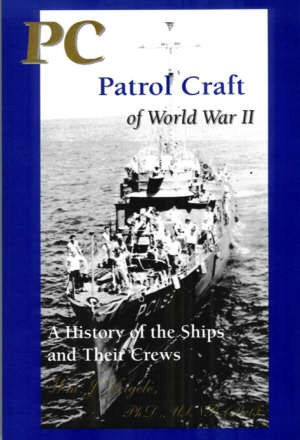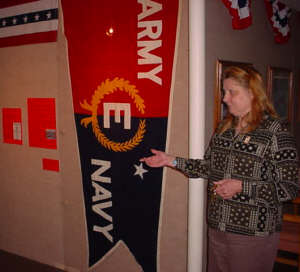Museum Gallery Fetes Patrol Craft Contribution to Victory in World War II
|
||||||||||
| Printer Friendly Story View |

Book by Dr. William J. Veigele, PC Patrol Craft of World War II, aims to give proper recognition to sub fighters that helped win the war.

Gay McInerney, executive director of the Bay County Historical Museum, introduces visitors to the new gallery honoring patrol craft sailors of World War II and the Defoe Shipbuilding Company's vital part in building the heroic little ships.
Reverse the spyglass of history and the contribution of the small industrial town of Bay City, Michigan, in changing the course of world history is clearly seen.
This viewpoint is portrayed in a new gallery featuring the patrol craft of World War II, recently opened at the Bay County Historical Museum, 321 Washington Avenue, Bay City.
The gallery was developed by Corrine Bloomfield, curator of exhibits, and is a major step toward recognizing the importance of patrol craft in winning the war and preserving world freedom.
The full drama of Bay City's contribution to the victory in World War II through the Defoe Shipbuilding Company deserves at least a full-length motion picture starring Charlton Heston as President Franklin D. Roosevelt.
Heston's boyhood home was in St. Helen, Michigan, and he often visited Bay City and has fond memories of the Wenonah Hotel, recalling especially the mosaic of Princess Wenonah that is now on display on the ground level of City Hall.
This bit of nostalgia sets the scene and the timeline for it originated in the pre-war days when Roosevelt and Bay City collaborated to help change the course of world history. Whether this is an overstatementwill be the judgment of the reader, but we believe it to be borne out by the facts related in this report.
Roosevelt showed great insight in authorizing in 1938 the design and construction of two small experimental steel-hulled submarine chasers, according to Dr. William J. Veigele, author of "PC Patrol Craft of World War II: A History of the Ships and Their Crews" (Astral Publishing Co., Santa Barbara, CA, 2003.)
Sidney A. Vincent of Newport News (Virginia) Shipbuilding Co.was selected from among 11 candidates as the designer of the ships. The Defoe Boat and Motor Works of Bay City, Michigan, in 1939 won the contract for construction of the ships. That same year Hitler secretly launched the 830 foot long battleship Bismarck that could sink ships 15 miles away and had the same mission as the U-boats, stop the merchant ships that were England's supply lifeline.
Defoe completed the first subchaser, PC 451, on 12 August 1940. The prototype PC had twin diesel engines. The firm then built PC 452 with an experimental steam engine, completing it in late 1941. Tests soon showed steam was impracticable and diesel was used on all other PCs, wrote Dr. Veigele.
Flash backward in time to the early days of the war. The Japanese had attacked Pearl Harbor on 7 December 1941. Allied leaders met shortly afterward in Washington with Roosevelt and British Prime Minister Winston Churchill and signed a United Nations Declaration to defeat the Axis powers.
Priority was to save England from the Nazis and keep the Japanese at bay in the Pacific. England's supply lifeline, vital to its survival, came across the Atlantic, mainly from the U.S., in slow, vulnerable merchant ships.
In the firstsix months of the war U-boats sank 600 Allied ships, half the U.S. merchant fleet. Hundreds of thousands of tons of tanks, guns, military vehicles and supplies went to the bottom, along with ships and crews. The British were using 750,000 tons of supplies more each month than were being delivering by the merchant ships. If England starved, Hitler would march in and the war would be virtually over. In such an eventuality, the U.S. of course would be direly threatened.
According to Dr. Veigele, Hitler held off on building more submarines because he was ahead of destroyer construction in the U.S. He didn't anticipate the advent of PCs or count on companies like Defoe that would spit out scores of the smaller, faster craft to harry the U-boats.
The convoy system used in World War I was revived and Churchill sent dozens of trawlers and corvettes to aid the U.S. protection of the merchant ships. Despite the use of destroyers, the Nazis with the submarine "wolfpacks" were sinking one ship a day, totaling 1,200 ships in 1942 alone. The Germans called this the "happy time," Veigele wrote, and the Allied war effort was nearly strangled.
Wealthy Americans like Henry Ford, the DuPonts and the Vanderbilts under Commander Vincent Astor converted 50 yachts to makeshift warships to help stem the German tide, but the U-boats were faster and had more firepower than all of them and the older submarine chasers as well.
It was at this critical juncture of history that workmen from Defoe rose up out of the mid-Michigan swamps to show the way to other shipyards across the nation in meeting the Nazi threat. After the Defoe prototype PC-451 showed promise, the Navy ordered 60 more 173-foot long patrol craft to be used as submarine chasers. They would pop out depth charges or shoot 60 pound bombs from decktop "mousetraps" or blast away with 3-inch guns or 40 mm machine guns if the Germans surfaced and were fast enough to snap at the heels until the U-boats were nothing but an oil slick in the Atlantic.
Defoe is considered the birthplace of the PC because the Bay City firm not only built the first two PCs but built more of the craft than the other 15 shipyards. The Defoe total of 58 PCs was possible in large part because of the "rollover" construction method devised by Harry J. Defoe. This allowed workers to weld "downhand," which saved time in training as well as fabrication. (It took several years for a welder to become competent in overhead work but onlya few months to learn to weld downhand, Veigele explains.) In full production, Defoe workers launched a PC every week and a DE (destroyer escort) every three weeks.
There are tales of "yardbirds," as the Navy called shipyard workers, stillwelding as the ships were sailed away, presumably to jump off at a handy port and take the bus or train back home. It took shipyards about six months to complete a PC, but Defoe built PC 549 in 91 days, beating Commercial Iron Works in Portland, Oregon by one day. The Navy had 361 PC-type ships built during the war at an average cost of $1.6 million each.
By March, 1943, deadly, scurrying PCs had helped overcome German domination of shipping lanes. U-boats were being sunk faster than they could be replaced. The Allies sank 779 U-boats and captured two, and about 60 apparently were scuttled. Some 28,000 German submariners died in their "iron coffins" and 5,000 were taken prisoner.
It was a close call; the war had very nearly been lost as the Nazis sank 2,882 Allied merchant ships by May, 1945. Churchill called the battle for the Atlantic "the dominating factor all through the war," according to author Veigele.
Hitler made many blunders during the war, but his worst may have been his delay in building more U-boats and underestimating the American production capabilities as personified by companies like Bay City's Defoe Shipbuilding Co.###
| Printer Friendly Story View |
|
|

Dave Rogers |
|
|
|
Printer-Friendly Story View
0200 Nd: 04-20-2024 d 4 cpr 0
12/31/2020 P3v3-0200-Ad.cfm
SPONSORED LINKS
12/31/2020 drop ads P3v3-0200-Ad.cfm


